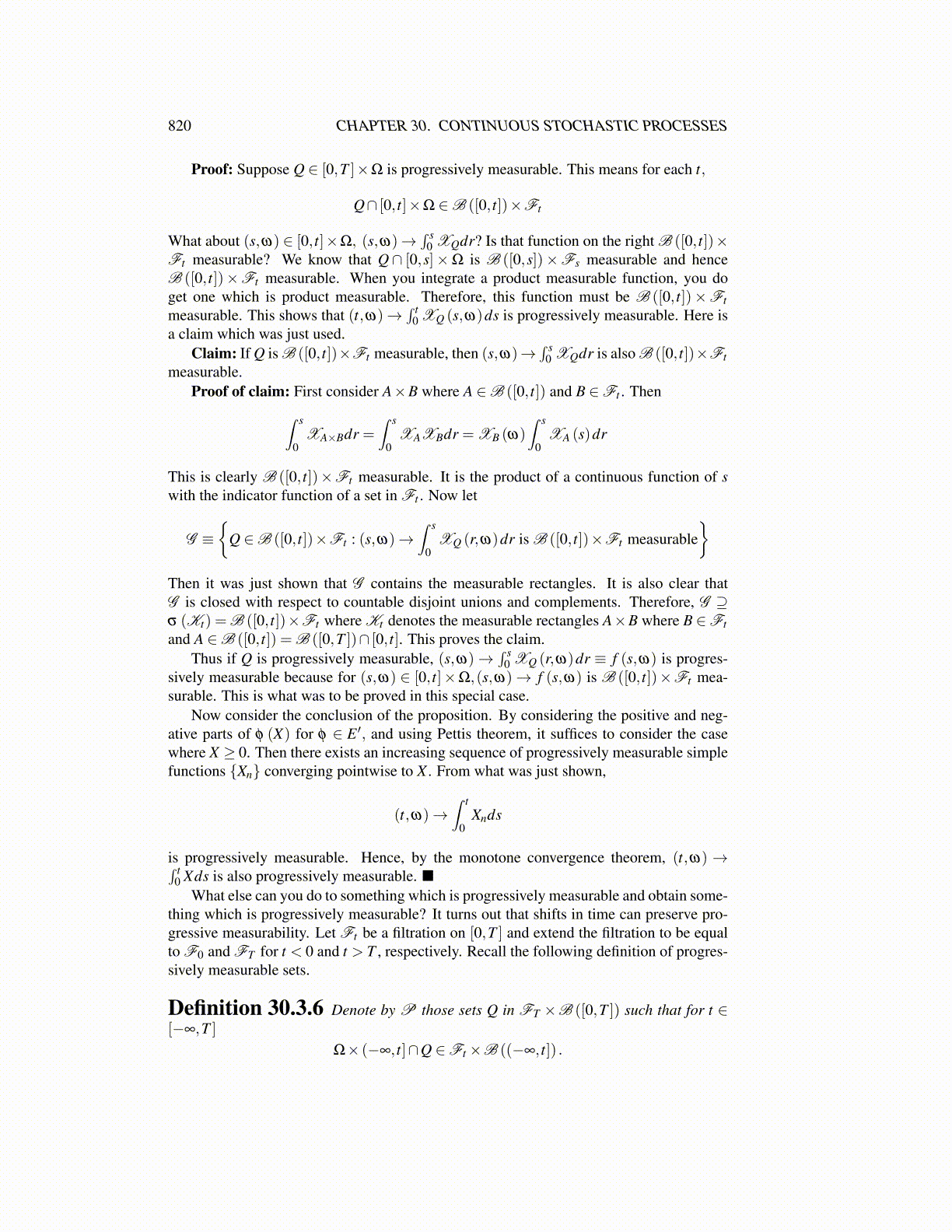
820 CHAPTER 30. CONTINUOUS STOCHASTIC PROCESSES
Proof: Suppose Q ∈ [0,T ]×Ω is progressively measurable. This means for each t,
Q∩ [0, t]×Ω ∈B ([0, t])×Ft
What about (s,ω) ∈ [0, t]×Ω, (s,ω)→∫ s
0 XQdr? Is that function on the right B ([0, t])×Ft measurable? We know that Q∩ [0,s]×Ω is B ([0,s])×Fs measurable and henceB ([0, t])×Ft measurable. When you integrate a product measurable function, you doget one which is product measurable. Therefore, this function must be B ([0, t])×Ftmeasurable. This shows that (t,ω)→
∫ t0 XQ (s,ω)ds is progressively measurable. Here is
a claim which was just used.Claim: If Q is B ([0, t])×Ft measurable, then (s,ω)→
∫ s0 XQdr is also B ([0, t])×Ft
measurable.Proof of claim: First consider A×B where A ∈B ([0, t]) and B ∈Ft . Then∫ s
0XA×Bdr =
∫ s
0XAXBdr = XB (ω)
∫ s
0XA (s)dr
This is clearly B ([0, t])×Ft measurable. It is the product of a continuous function of swith the indicator function of a set in Ft . Now let
G ≡{
Q ∈B ([0, t])×Ft : (s,ω)→∫ s
0XQ (r,ω)dr is B ([0, t])×Ft measurable
}Then it was just shown that G contains the measurable rectangles. It is also clear thatG is closed with respect to countable disjoint unions and complements. Therefore, G ⊇σ (Kt) = B ([0, t])×Ft where Kt denotes the measurable rectangles A×B where B ∈Ftand A ∈B ([0, t]) = B ([0,T ])∩ [0, t]. This proves the claim.
Thus if Q is progressively measurable, (s,ω)→∫ s
0 XQ (r,ω)dr ≡ f (s,ω) is progres-sively measurable because for (s,ω) ∈ [0, t]×Ω,(s,ω)→ f (s,ω) is B ([0, t])×Ft mea-surable. This is what was to be proved in this special case.
Now consider the conclusion of the proposition. By considering the positive and neg-ative parts of φ (X) for φ ∈ E ′, and using Pettis theorem, it suffices to consider the casewhere X ≥ 0. Then there exists an increasing sequence of progressively measurable simplefunctions {Xn} converging pointwise to X . From what was just shown,
(t,ω)→∫ t
0Xnds
is progressively measurable. Hence, by the monotone convergence theorem, (t,ω) →∫ t0 Xds is also progressively measurable. ■
What else can you do to something which is progressively measurable and obtain some-thing which is progressively measurable? It turns out that shifts in time can preserve pro-gressive measurability. Let Ft be a filtration on [0,T ] and extend the filtration to be equalto F0 and FT for t < 0 and t > T , respectively. Recall the following definition of progres-sively measurable sets.
Definition 30.3.6 Denote by P those sets Q in FT ×B ([0,T ]) such that for t ∈[−∞,T ]
Ω× (−∞, t]∩Q ∈Ft ×B ((−∞, t]) .